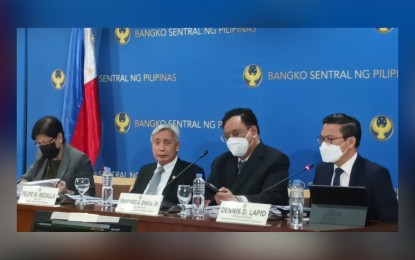
KEY RATES HIKE. Bangko Sentral ng Pilipinas (BSP) Governor Felipe Medalla (2nd from left) discusses the decision of the policy-making Monetary Board (MB) to hike the central bank's key rates by 50 basis points on Thursday (Feb. 16, 2023). The rate hike was attributed to the higher-than-expected inflation rate last January at 8.7 percent and the continued recovery of the domestic economy. (PNA photo by Joann S. Villanueva)
MANILA – Elevated domestic inflation rate continues to remain as a main factor for the upward adjustments in the Bangko Sentral ng Pilipinas’ (BSP) key rates, which were hiked by 50 basis points on Thursday.
In a briefing, BSP Governor Felipe Medalla said the rate uptick will take effect this Friday and this will bring the overnight reverse repurchase (RRP) rate to 6 percent, same as in August 2008; the overnight repurchase rate to 6.5 percent and the overnight deposit rate to 5.5 percent.
“In deciding to raise the policy interest rate anew, the Monetary Board noted that the latest baseline inflation forecast path has shifted higher relative to the previous assessment,” he said.
This, as monetary authorities now see inflation averaging at 6.1 percent this year, higher than the 4.3 percent last November and way higher than the government’s 2 to 4 percent target band.
For 2024, the average is expected to slow to 3.1 percent, same as that last November.
Monetary authorities said upside risks to inflation include the higher global and domestic food prices, transport fare hikes, higher sugar prices and higher wage adjustments.
Medalla said the upward adjustment in the average inflation forecast was partly due to the higher-than-expected 8.7 percent inflation rate last January, a new 14-year high, and surpassed expectations that rate of price increases likely peaked last December.
He said inflation is seen to go back to within-target level by October this year.
Medalla said the stronger recovery of the domestic economy, which exceeded the government’s 2022 growth assumption of 6.5 to 7.5 percent after expanding by 7.6 percent, is also a factor for the acceleration of inflation rate.
“Both headline and core inflation measures have also continued to increase, indicating a further broadening of price pressures, particularly in services,” he said, adding “inflation expectations have likewise risen further, underscoring the need to pre-empt the emergence of further second-round effects.”
Medalla said that since inflation is driven by supply shocks, he supports the government’s measures to import additional food items as well as any measures that will boost productivity.
He said the latest rate adjustment in the central bank’s key rates is “a strong follow-through monetary policy response” and is needed “to reduce the risk” of a breach of the inflation target next year, which remains between 2 to 4 percent.
Medalla said the rate hike “would also prevent inflation expectations from drifting further away from the target band.”
“The Monetary Board also believes that with domestic growth exceeding expectations in 2022, monetary action can help to dampen potential demand-side pressures and second-round effects without unduly hindering the sustained momentum of economic growth,” he said.
He said a 50 basis points increase in the central bank’s key rates will likely cut domestic output by 0.04 percent.
Medalla discounted a pause in the central bank’s rate hiking cycle in the near term given the elevated inflation rate and the sustained recovery of the domestic economy.
“It’s unlikely that we will not increase the rate in (the) next meeting,” he said.
Medalla said a cut in banks’ reserve requirement ratio (RRR) remains on the table , at least within the first half of this year, but not while the BSP is hiking its key rates so as not to confuse the market and to disadvantage the banks.
This, as a rate hike would result in tighter liquidity while an RRR cut would release additional liquidity into the financial system.
“Personally, I still think that given what will happen I still think that cutting reserve requirements before the end of the first semester is still feasible,” he added. (PNA)
